|
It’s hard not to feel for Robert Graham (Phillips Holmes). He’s only been in town a month, has recently lost his job and he didn’t want to spend his 20th birthday alone, so he invited a young girl he met on the street to go dancing with him. Once at the club, however, the son of a wealthy and well-connected bigwig began harassing the young woman, and when he reached for his back pocket, Robert feared the worst and swung a water jug at him. The resulting blow to the head knocked the man cold and he later dies of his injuries. Robert is arrested at the scene and is too shaken to offer much in the way of a defence, which makes it easy work for District Attorney Mark Brady (Walter Huston) to get a conviction that lands the still shaken young man with a ten-year jail sentence for manslaughter.
I’ve slightly juggled the order in which above information is revealed and left out a few small details, but that’s the gist of what happens suring the course of the film's first 15 minutes, and as Robert is led from the court following his conviction, it feels almost like the final scene of a movie that has come to a premature end. This, of course, is what happens when you sit down to watch a film without reading anything about it and are blissfully unaware that this is all effectively setup for what has to be classified as a prison movie. Once I realised this, I was still thrown a little by the knowledge that Walter Huston was the film’s top-billed star, yet as Robert’s prosecutor in the court case that landed him in the clink, I couldn’t see what further role he might have to play in a story that from this point would likely be set entirely within the prison walls. Clarification comes when, after six years pass in a mere few seconds of screen time, Brady becomes the new warden of the prison in question, having recently failed in his bid to become state Governor. He’s fully aware that his new posting is not without its dangers, as in his former role as District Attorney he was responsible for convicting many of this institution’s current inmates and is thus widely despised even before takes up the job. When he looks down at the crowded exercise yard on his arrival, the sight of him triggers a loud and aggressive vocal protest, one he directly confronts by lighting a cigar and walking unaccompanied into the yard in a sort of “come on, then!” challenge to anyone willing to risk the consequences of taking a pot-shot at him. To borrow a famous line from the head of the firing squad in Blackadder Goes Forth, I’ve got to admire your balls, sir.

By this point, Robert has been toiling away for years in the noise, dust and heat of the prison's jute mill and is struggling to hang on to what is left of his humanity. His condition is a cause of concern for his cellmates, the fatherly Jim Fales (Otto Hoffman) and the tough but sympathetic Galloway (Boris Karloff). Jim offers Robert a ray of hope when he reveals that he has devised an escape plan, which Robert then desperately begs to be part of. When Fales asks Galloway if he wants in on it too, he says he has other plans, having found himself in the same prison as Runch (Clark Marshall), the worthless weasel who snitched on him and landed him with a 12-year stretch for drinking a beer while on probation during a time of national prohibition. As it turns out, both plans are set to later impact on the fate of each of the three men in different ways.
Elsewhere, expectations are nicely usurped. Having watched Brady enthusiastically outline to his colleague at the D.A.’s office how he could get Robert off on a charge of self-defence if he was his lawyer, I assumed that he had remained sympathetic to Robert’s case and would take a special interest in him when he became the warden. Yet when Robert is brought before him by the prison doctor, mentally and physically crushed by his time in the jute mill and brought to the brink of despair by the news of his mother’s death (the way this is revealed is a masterclass in subtle cinematic storytelling), Brady doesn’t initially remember him and tries to break the ice with the very same question he asked when the two first met. Robert, meanwhile, no longer holds Brady any particular ill will, not out of a sense of forgiveness but because six years of prison life have so effectively beaten him down. His transformation from a frightened youth into a broken shell of a man doubtless contributes to Brady’s initial lack of recognition, as well as his subsequent decision to give the boy a break by...
OK, here’s the thing. I’ve never done time and even those I’ve known who have did so in British prisons in the later part of the twentieth century, so I have no personal or even second-hand experience to draw on. From what I’ve read, however, conditions in American jails of the period were even worse than those portrayed in the film, and prisoners were treated more like caged animals than wayward citizens. You do get a flavour of this in The Criminal Code, in the grimly narrow cells into which three prisoners are jammed and in the callous brutality of head guard, Captain Gleason (DeWitt Jennings), which is why what happens to Robert when he’s led to Brady’s office initially prompted an eyebrow raise on my part. As Brady recalls the case that first brought the young man before him six years earlier, his pretty and stylishly dressed daughter, Mary (Constance Cummings), walks in to announce that tea is ready. The sight of her appears to momentarily wake Robert from his malaise, and with the doc recommending a change of occupation and environment, Brady promptly makes Robert his chauffeur, a job that also allows him to spend time alone with Mary and help her out at home. What, really? Now can’t say with any authority that this would or would not have occurred in the real-world equivalent of the day, but given how prisoners tended to be treated and regarded by those charged with keeping them locked up, this represents one hell of an act of trust on Brady’s part, even for a man supposedly sympathetic to Robert’s case. It’s not that Robert can’t be trusted, it’s just that there’s little reason supplied here for Brady to so quickly decide that he can be and to have complete faith that the daughter he dotes on would be safe in his company. Then again, maybe this was the intended point. The topic of prison reform made its way into a handful of socially conscious Hollywood films of the early 1930s, the most celebrated of which remains Mervyn LeRoy’s searingly powerful 1932 I Am a Fugitive from a Chain Gang. Is the trust Brady places in Robert and the positive effect it has on him a subtle plea for a more humane and progressive approach to rehabilitation? I’d like to think so. That said, there also can’t be many who will not guess where the friendship that develops between Robert and Mary as a result of the time they spend together is ultimately set to head, and I was left wondering whose idea it was to appoint Galloway, of all people, as the Brady family butler, as his very presence seems to scare the bejesus out of prissy housekeeper, Katie Ryan (Ethel Wales).
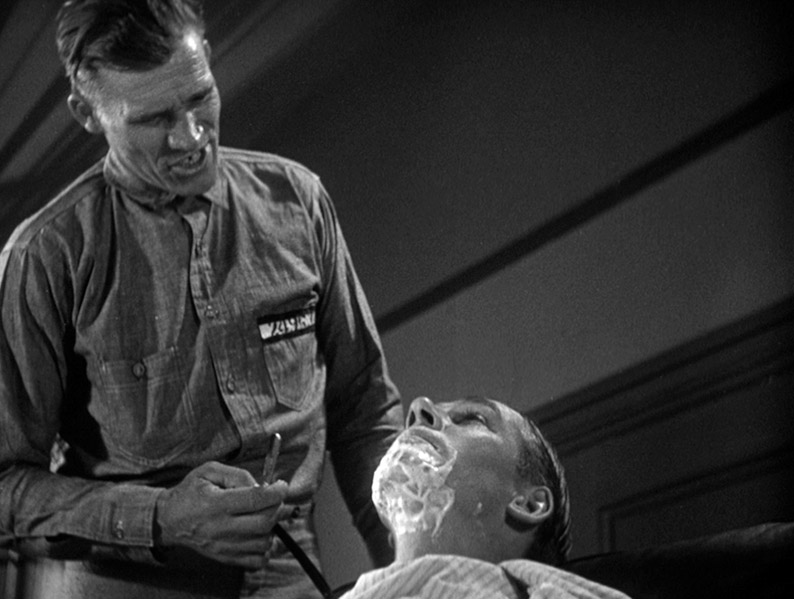
The Criminal Code was an early feature work from director Howard Hawks, and if you didn’t know that when you sat down to watch it then you’d soon be clued in by the opening scene, with its bantering detectives and pioneering use of overlapping dialogue, which went on to become a signature feature of later Hawks movies. This complex but carefully crafted technique (Hawks later revealed that the information the audience needed to hear was always located in the portions of the dialogue that didn’t overlap) is all the more impressive here for being test run in a film made so early in the evolution of synchronised sound cinema. This ensures that the film starts in high gear and Hawks keeps things moving at a brisk pace, making creative and purposeful use of camera placement, actor blocking and editing (a nod of appreciation to editor Edward Curtiss). He even includes a couple of expressionistic montages, the first to suggest the impact of the jute mill noise on Robert’s fragile wellbeing, the second the mayhem and dark intent of a carefully coordinated verbal riot, a sequence whose sound design is also worthy of note. There are also odd moments of dark humour in Fred Niblo Jr. and Seton I. Miller’s screenplay that Hawks plays up nicely, my favourite being a scene in which Brady is being shaved by a prisoner named Red Fleischer (Bob Kortman), whom Brady has selected to be his barber. When Fleischer confirms that it was Brady who sent him down for life, Brady calmly asks, “What for?” to which Fleischer replies stonily, “For cuttin’ a guy’s throat,” before taking a razor to the stubble beneath the warden’s chin.
The casting and some of the performances are of a very high order. Walter Huston makes Brady a far more interesting figure than the character of a prison warden with a conscience could in lesser hands have been, indignantly laying out the ideal defence for Robert’s actions one minute and soundly prosecuting him the next, primarily because doing so will be beneficial to his run for state Governor. Even after cutting Robert a timely break in prison, he’s still able to switch back to prosecutor mode and lean mercilessly on him when the criminal code of the prisoners comes into conflict with the one that Brady lives and makes his judgements by. As a result, he’s neither an easily likeable or dislikeable character and one I was never sure quite how I felt about, a self-confident believer in the rule of law who under the right circumstances might still be prepared to risk his own career to do what is right. As Robert, Phillips Holmes may not be able to match the more nuanced performance given by Glenn Ford in the same role in the 1950 remake, Convicted, but in an odd way is more effectively cast. Fine though he is in the later film, Ford is older and stockier than Holmes and frankly has the air of someone who could take care of himself in prison. Holmes, on the other hand, looks every inch the vulnerable and frightened young innocent that Robert is initially presented as and appears convincingly worn down by the system when he is brought before the new warden.
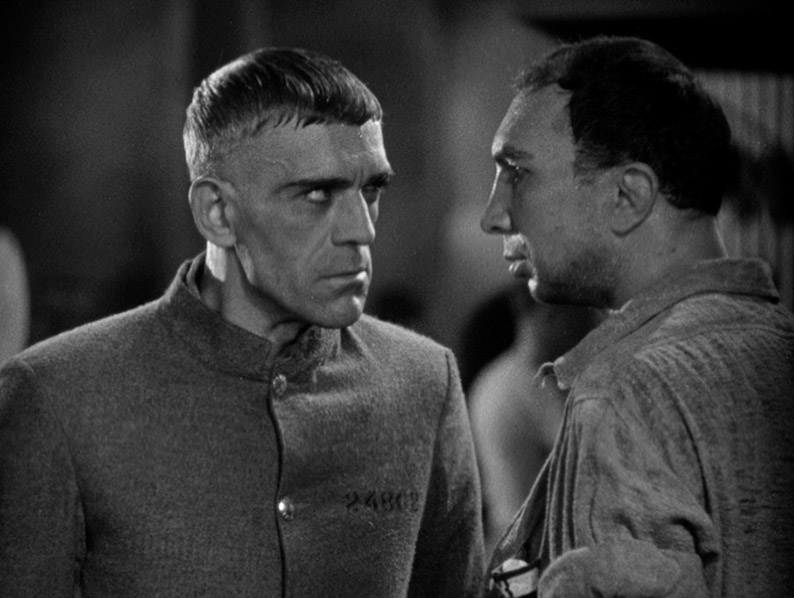
A solid supporting cast that was apparently peppered with ex-convicts helps make the prison feel a distinctly uncomfortable place in which to spend time, and even here some of the actors are able to make their mark. Clark Marshall does a nice line in cowardly and terrified self-interest as the squealer Runch, DeWitt Jennings sets the template for future abusive prison guards as Captain Gleason, and I particularly liked Bob Kortman’s short but almost scholarly affirmative responses to Brady’s questions during the above-mentioned shaving scene. But the supporting player who shines the brightest here is Boris Karloff as the vengeful Galloway, with his angular features, furrowed brow and mannered delivery ensuring that he oozes controlled menace from his very first scene. His barely suppressed anger as he recalls how he ended being bounced back to prison after taking a drink while on probation – which is captured in a single close-up that sees Karloff lean so far forward that he slips out of focus – leaves you in no doubt about the violence he plans to unleash on Runch, despite not being specific about his intentions. Perhaps the moment that best captures the threat he represents, a threat that the guards also seem to be well aware of, comes after Robert has had a minor breakdown in his cell and has been silenced by his cellmates for his own protection. When Gleason reacts to the noise by demanding that the now unconscious Robert be handed over to him, Galloway calmly responds with a delicious air of implied menace, “Come in and get him.” It’s no surprise that Gleason ultimately elects to let it go.
The Criminal Code is one of the films that helped define the prison movie subgenre and for me is one of its most enjoyable and accomplished early works. Later entries would be more hard-hitting, from the chilling bleakness of the aforementioned I Am a Fugitive From a Chain Gang to the tough realism of Brute Force and beyond, but Hawks and his collaborators helped to lay the foundations for all of them and in the process created a work that belies its theatrical origins and succeeds on cinematic as well as dramatic terms. A smart screenplay, skilful direction, strong performances, and that opening sequence taste of things to come make this a key work from a filmmaker whose career was littered with key works and whose next film, Scarface, would see him soar to even greater heights as a crime movie director. It’s also credited with kicking off the career of an up-and-coming actor who the following year would see his fortunes ever changed when he was cast as The Creature in James Whale’s Frankenstein. Indeed, I’d be willing to champion the film for Karloff’s work in it alone, but that’s just one facet of a gripping work that handily reminds us of how quickly some filmmakers adapted to the new possibilities opened up by the arrival of synchronised sound.
Sourced from an HD remaster by Sony, this 1080p transfer is framed in the film’s original aspect ratio of 1.37:1 and for a film of this vintage is in surprisingly good shape. While not razor-sharp, picture detail is still clearly defined, only softening in a couple of wider shots of prisoners marching, which also display slightly more wear than you’ll find elsewhere. The contrast balance is generally well judged, with punchy black levels and no highlight burnout, and the image is stable in frame and generally clean, with only a few minor dust spots visible here and there. A film grain is visible throughout and pleasingly shows no sign of digital enhancement.
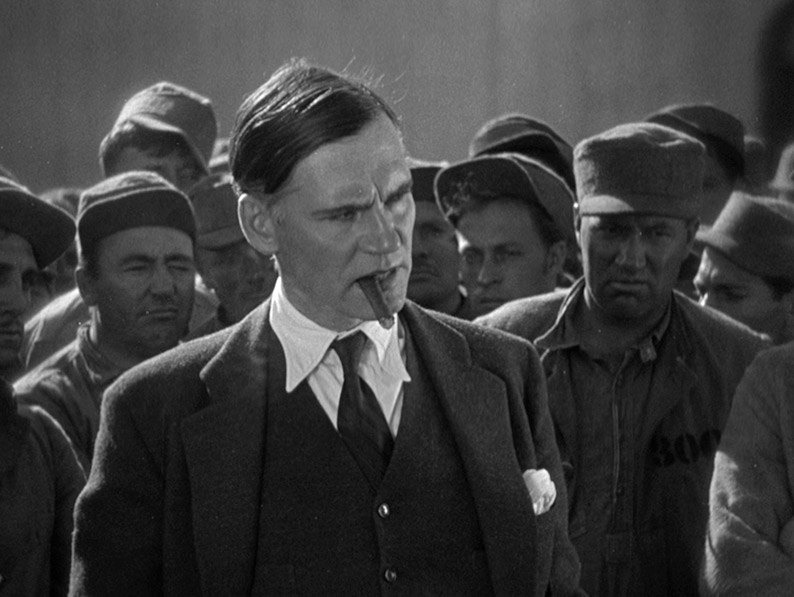
The Linear PCM 1.0 mono soundtrack more readily shows its age, with a very limited dynamic range that can sound a little tinny at times and some audible background fluff and hiss. Given that the film went into production less then three years after the first synchronised sound film hit cinemas this is hardly surprising, and despite all this the dialogue is always clear and there are no alarming pops of damage to contend with.
Optional English subtitles for the deaf and hearing impaired are available.
Audio Commentary with Nora Foire
The ever energetic and enthusiastic film historian Nora Foire is back, hot on the heels of her detailed examination of Tight Spot as part of Indicator’s Columbia Noir #2 box set, to provide a similarly exhaustive look at The Criminal Code, of which she is clearly a fan. As before, there is so much discussed here that I felt the need to immediately re-watch the film in light of what I learned, with Foire highlighting the differences between the film and the Martin Flavin stage play from which it was adapted and providing always interesting readings of individual characters and scenes, as well as details on the actors, the director, the screenwriters, the Spanish and French language versions of the film, why original cinematographer James Wong Howe was replaced by Ted Tetzlaff, and so much more. We get information on how much worse the jute mill at San Quentin was than the one portrayed in the film, the true story of imprisoned Los Angeles County district attorney Asa Keys, on whose actions Mark Brady’s defiant walk into the prison yard were apparently based, and even an analysis of the various ways that Walter Huston says the word, “Yeah.” A fascinating and educational companion to the film.
Behind the Mask: Kim Newman on Boris Karloff (25:16)
Critic and author Kim Newman examines the non-horror career of one of his favourite horror stars, providing a detailed overview of many of the films in which Karloff appeared that do not fit that genre classification. He cannily describes the actor’s performance as Galloway in The Criminal Code as the sort of eye-catching role that prompts producers to say, “Get me that guy from that film who did that,” and reminds us that this was the film that Karloff and Peter Bogdanovich sat down to watch in the latter’s electrifying debut feature, Targets. Newman’s knowledge of his subject is as impressive as ever (he never consults notes and yet is able to go into remarkable detail without pausing for breath), so it didn’t come as a complete surprise when he revealed that he’s currently writing a book about Karloff and his film career. As an aside, the book on Karloff’s film career that has been carefully displayed on the bookcase behind him – The Films of Boris Karloff by Richard Bojarski and Kenneth Beals – is one that I also own and regularly consult.
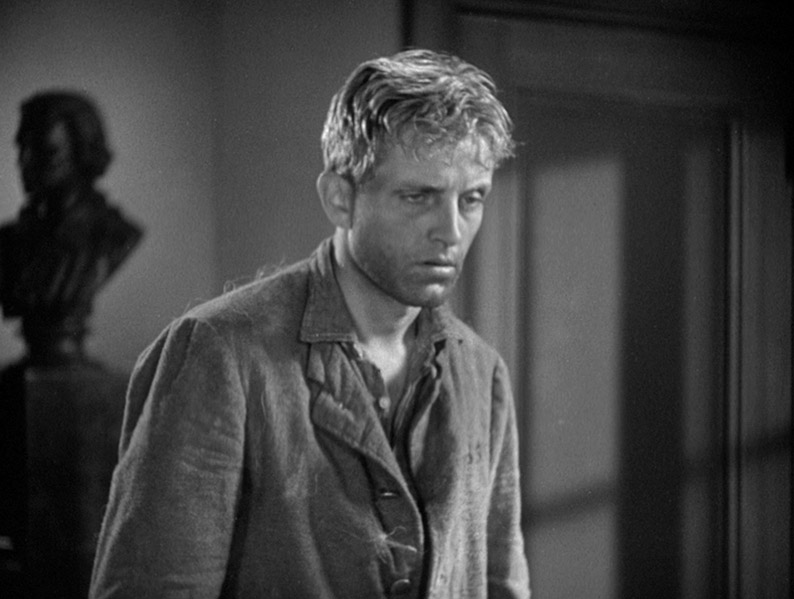
Codes and Convictions (29:12)
Written and edited by Jonathan Bygraves, this is the sort of special feature I adore for the specifics of its detail and the clarity of its presentation. Using textual captions and side-by-side film clips, it compares sequences in The Criminal Code with two later film adaptations of the same source material, the 1938 Penitentiary, directed by John Brahm and starring Walter Connolly and John Howard, and the 1950 Convicted, directed by Henry Levin and starring Glenn Ford and Broderick Crawford. Inevitably, this means there are major spoilers for all three films here, something that is thoughtfully flagged up front, but if you know the films or are prepared to risk knowing how the later ones differ from The Criminal Code, this is a really well researched and executed extra that I personally found fascinating.
The Howard Hawks Masterclass with John Carpenter (36:14)
An audio recording made for archival purposes rather than public consumption, this lecture on Howard Hawks by Hawks devotee John Carpenter kicks off as an enthusiast’s trip through film clips we are unable to see but moves into more interesting territory when Carpenter gets into the specifics of the Hawks style and approach. I certainly wasn’t aware of his technique of having the actors improvise around the written dialogue to develop scenes in pre-filming rehearsals, or that he often rewrote scripts so that the dialogue would better match the way his chosen actors naturally spoke. When the floor is opened to almost inaudible audience questions that are clarified by the on-stage host or by Carpenter’s responses, the main focus is Carpenters’ remake of the Hawks-produced The Thing From Another World, and Carpenter has his own opinions on whether Hawks really directed it and why it was credited to his editor, Christian Nyby.
Lux Radio Theatre: The Criminal Code (1937) (58:34)
First transmitted on 18 January 1937, this Lux Radio Theatre adaptation of The Criminal Code stars Edward G. Robinson, Beverly Roberts, Paul Guilfoyle and Noel Madison, and pleasingly has had the usual ad breaks to sell Lux soap edited out. Edward G. Robinson is definitely the star here, and while he makes for a fine Mark Brady, some changes have been made here to present him as a more straightforwardly benevolent and sympathetic figure who really believes in Robert and wishes him no harm, which for me made him a little less interesting than his film equivalent. Some scenes play out closely to how they were in the film and with the same or similar dialogue, but the humanising of Brady goes into sentimental overdrive in a finale that can’t really hold a candle to that of the movie. In an unexpected but related intermission, former San Quentin warden James Bernard “Big Jim” Hollahan tells the true story of when four convicts invaded his on-site house, knocked him out and made their escape bid, which didn’t end well for any of them. What’s unexpectedly serendipitous about this aside is that Hollahan was San Quentin warden when the aforementioned Asa Keys was incarcerated there.
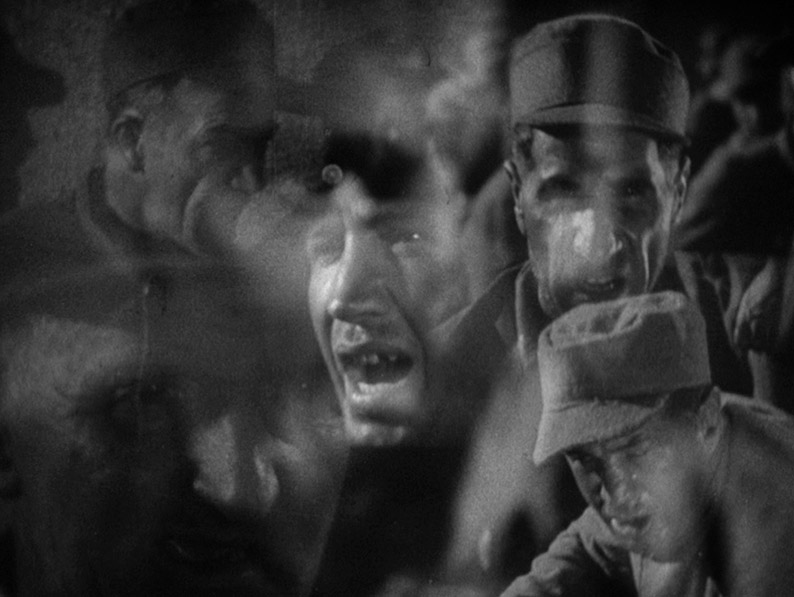
There are two Image Galleries included here. The Criminal Code consists of 25 screens of promotional photos, blindingly luminous coloured-in lobby cards, and posters for the English language version of the film. El Código penal has 23 screens of stills and two of what looks like pages from a handout or press book from the Spanish language version of the film, which was produced in tandem with the English language version and shot at night on same sets with a different cast. It was directed by Phil Rosen, starred Barry Norton, Carlos Villarías and Maria Alba, and is now considered a lost film, but the stills give a flavour of how visually similar the two versions likely were.
Booklet
The lead essay here is by freelance reviewer, film historian and lecturer Philip Kemp, who provides a concise overview of the film and its qualities. Next up are extracts from the interview-driven book, Hawks on Hawks, in which the director recalls his prep work for The Criminal Code, working with Walter Huston and more. A 1963 analysis of Hawks’ career by archivist, cinephile, and co-founder of the Cinémathèque Française, Henri Langlois, makes for interesting reading, even if The Criminal Code doesn’t get a mention, and as a former art student, I did like his description of Hawks as the “Le Corbusier of the sound film.” Finally, we have three extracts from contemporary reviews, and a 1984 re-evaluation of the film written by Jonathan Rosenbaum for Monthly Film Bulletin. Full credits for the film are included and the booklet is illustrated with promotional imagery.
One of Howard Hawks’ less frequently cited and discussed early sound films, The Criminal Code is a very well written, directed and acted prison movie from the early days of sound cinema, one whose best sequences are genuinely outstanding. A fine transfer is backed by a solid collection of quality special features, making this a must-have for fans of Hawks, of Karloff, of prison movies or of quality early Hollywood sound cinema in general. Enthusiastically recommended.
|